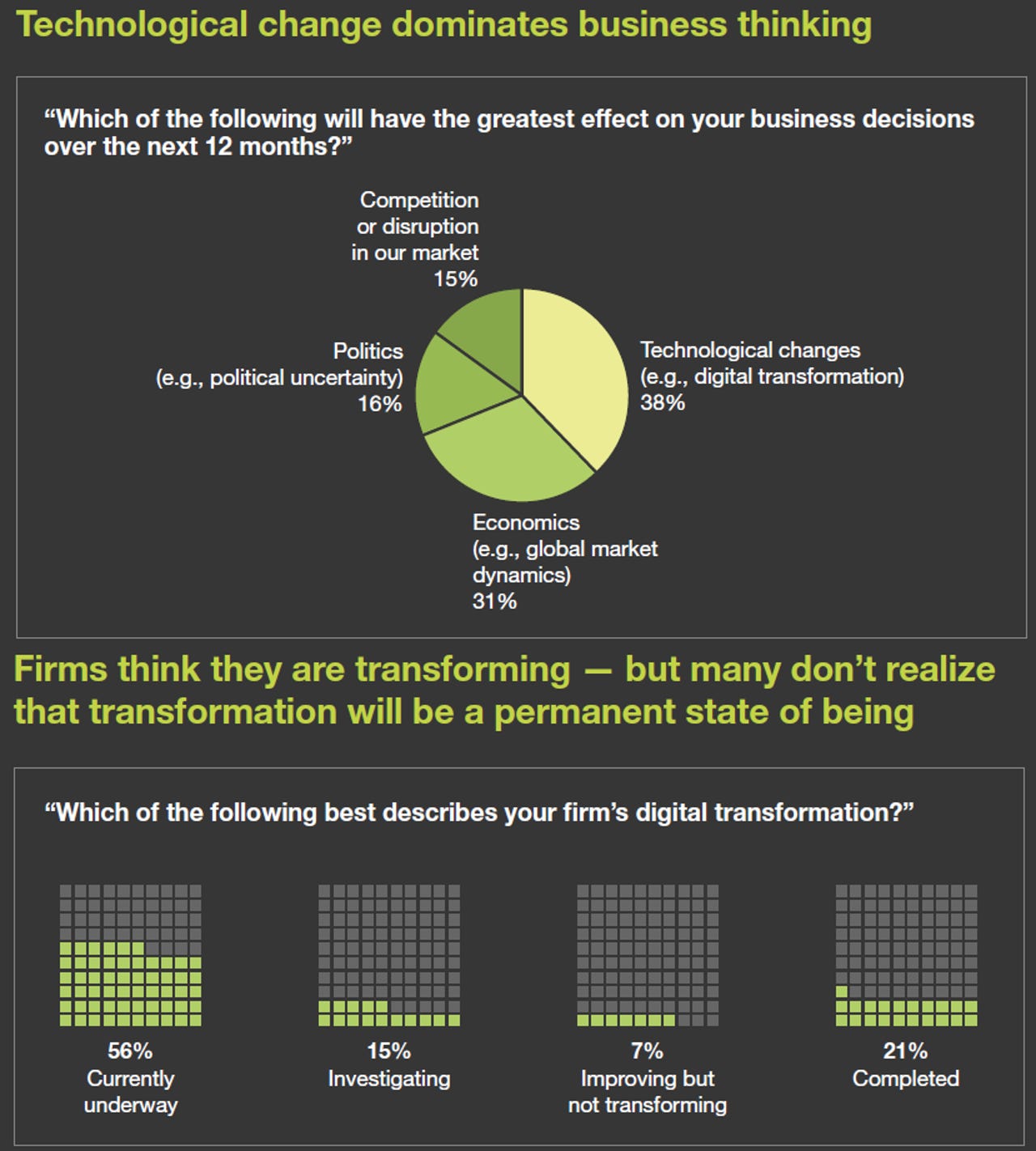Research round-up: Cloud computing, IoT and cybersecurity, iPhone X and more


Digital transformation efforts are running into roadblocks
Rounding up the charts that explain the tech news of the month.
Let's start with digital transformation - and it's not a rosy picture. A Forrester survey of 1,559 business and technology decision makers found that digital transformation efforts are running into roadblocks amid confusion, delusion and resistance to change. Yet, somewhat remarkably, 21 percent of execs even think their business has already digitally transformed.
Cloud infrastructure-as-a-service is a fast-growing area
Businesses that are looking to transform digitally remain firmly focused on the cloud. Worldwide spending on public-cloud services will grow 21.4 percent this year to $186.4bn, up from $153.5bn in 2017, according to analyst firm Gartner. The fastest-growing segment of the market is cloud infrastructure-as-a-service (IaaS), which it forecasts to grow 35.9 percent in 2018 to reach $40.8bn.
Companies lagging on multi-cloud plans
Yet there is still much work to do when it comes to moving to on-demand platforms. Researcher IDC found only nine percent of European organisations can be considered multi-cloud ready ('Pathfinders'), with the vast majority still stuck in the transition process from hybrid cloud environments ('Pedestrians' and 'Travelers').
The next trillion IoT devices
IT leaders are also pushing their transformation efforts beyond the cloud and into advanced technologies, like the Internet of Things (IoT). This figure shows Arm's projected breakdown of the one trillion IoT devices that it predicts will be built between 2017 and 2035. Firms involved in IT services ($450bn/yr), telecoms services -- including 5G and its successors -- ($150bn/yr) and installation services ($100bn/yr) have a lot to play for.
Annual spend on IoT systems in 2035
By 2035, according to Arm's analysis, the IoT's boost to global GDP will be $5 trillion, the annual spend on IoT hardware and services will be $1 trillion (see figure above), the cumulative spend on IoT connectivity modules from 2017 will be $750 billion, and one trillion IoT devices will have been built since 2017.
Worldwide IoT security spending
The likely growth in the number of IoT devices and the pressing need to secure them has led analyst firm Gartner to predict that spending on IoT security will total $1.5 billion in 2018 (up 28% from 2017) and reach $3.1 billion by 2021 (up 107% from 2018).
How would you describe your company's cybersecurity strategy?
Security concerns extend far beyond IoT. ZDNet's sister site Tech Pro Research conducted an IT leadership survey posing the question: 'Is your company succeeding or failing at cybersecurity?' The results suggest there's a long way to go towards the ideal where companies have a clear picture of the threat landscape.
How confident are you in your company's cybersecurity measures?
The Tech Pro analysis also covered cybersecurity confidence. Given that 61 percent of respondents' companies lack a regularly reviewed and updated security policy, it's no surprise that only 15 percent are 'very confident' in the security measures that are currently in place.
Cybersecurity focus areas
So, how can CIOs build confidence when it comes to information protection? Security consultancy Mandiant has developed a 10-component framework for creating a cybersecurity programme. As part of its research, the firm reports the most commonly cited focus areas across all vertical industries are data protection and incident response, closely followed by identity and access management.
Beware of the outsider threat
IT leaders must also pay attention to external security risks. Last year, almost three quarters (73 percent) of cyberattacks were perpetuated by outsiders, according to the 2018 Verizon Data Breach Investigation Report. Organised criminal groups were behind half of all breaches, with nation states or state-affiliated actors involved in 12 percent.
Large number of missing high-severity patches
Efforts to maintain information integrity can be stalled by low levels of patching. Critical patches that should be on devices aren't actually present, according to a study by researchers Karsten Nohl and Jakob Lell of German security firm Security Research Labs. The results, shared with Wired, show popular Android devices are missing as many as a dozen patches that users would expect to be there.
Top 10 smartphones by share of worldwide handset profits in Q4 2017
Finally, while Android devices are important for enterprise security managers, the iPhone X accounted for 35 percent of worldwide smartphone profits in the last quarter of 2017, according to a report by Counterpoint Research. Of the top 10 phones by profitability in the quarter, the only non-iPhone devices in the list are Samsung's Galaxy Note 8 and Galaxy S8 Plus.